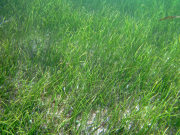Go offline with the Player FM app!
Take and Give
Manage episode 427616227 series 63973

For the seagrass beds of southern Texas, rising sea level may be a case of give and take—or make that take and give. Higher waters are killing off some seagrass. But as the water rises even higher, newly submerged land has the potential to increase the total seagrass area.
Seagrass is important for many coastal ecosystems. It can protect the coast from storms, filter pollution from runoff, and provide habitat and food for fish and other life. So losing seagrass is a big deal.
Researchers at the University of Texas Marine Science Institute studied beds in Upper Laguna Madre—a narrow estuary behind Padre Island. They looked at the beds today, and examined records from the past three decades.
Sea level in the region is rising much faster than the global average—roughly half an inch to an inch per year. As the water rises, less sunlight reaches the bottom—a big problem for seagrasses. Because of the deeper waters, two species of seagrass have vanished since 2018 at one study location. A check on a wider area showed that seagrass had disappeared at almost a quarter of the sampled locations.
On the other hand, seagrass may colonize newly submerged regions. That could expand its total habitat by as much as 25 square miles by 2050.
Not every seagrass habitat will be that prolific. Beds in much of the world are hemmed in by development, so they have no place to go. For those regions, there won’t be much give and take—rising sea level will be all take.
90 episodes
Manage episode 427616227 series 63973

For the seagrass beds of southern Texas, rising sea level may be a case of give and take—or make that take and give. Higher waters are killing off some seagrass. But as the water rises even higher, newly submerged land has the potential to increase the total seagrass area.
Seagrass is important for many coastal ecosystems. It can protect the coast from storms, filter pollution from runoff, and provide habitat and food for fish and other life. So losing seagrass is a big deal.
Researchers at the University of Texas Marine Science Institute studied beds in Upper Laguna Madre—a narrow estuary behind Padre Island. They looked at the beds today, and examined records from the past three decades.
Sea level in the region is rising much faster than the global average—roughly half an inch to an inch per year. As the water rises, less sunlight reaches the bottom—a big problem for seagrasses. Because of the deeper waters, two species of seagrass have vanished since 2018 at one study location. A check on a wider area showed that seagrass had disappeared at almost a quarter of the sampled locations.
On the other hand, seagrass may colonize newly submerged regions. That could expand its total habitat by as much as 25 square miles by 2050.
Not every seagrass habitat will be that prolific. Beds in much of the world are hemmed in by development, so they have no place to go. For those regions, there won’t be much give and take—rising sea level will be all take.
90 episodes
All episodes
×Welcome to Player FM!
Player FM is scanning the web for high-quality podcasts for you to enjoy right now. It's the best podcast app and works on Android, iPhone, and the web. Signup to sync subscriptions across devices.




